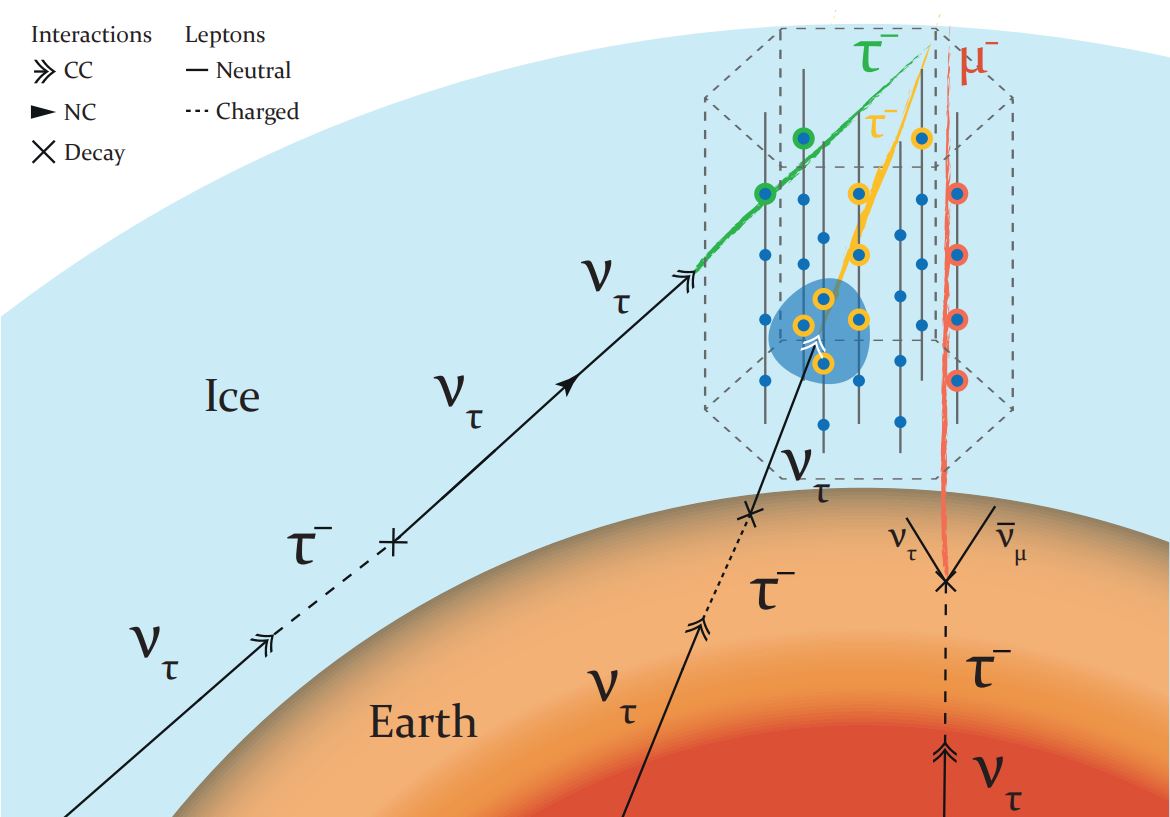The IceCube Neutrino Observatory has seen some fairly high-energy neutrino events. With its array of over 5,000 optical modules buried in the ice at the South Pole, IceCube has picked up signals from particles with energies in excess of a thousand-trillion electronvolts. But IceCube researchers are still waiting for a detection of something a thousand times more energetic: an ultra-high-energy neutrino that is part of the cosmogenic (or GZK) neutrino flux.
Named for the theoretical upper limit of cosmic-ray energies (the Greisen–Zatsepin–Kuzmin limit), GZK neutrinos are born when high-energy cosmic rays travel through the intergalactic medium and interact with light from the cosmic microwave background, producing charged particles that decay to neutrinos. Together, these extremely high-energy neutrinos make up the GZK neutrino flux. Scientists know this flux exists, but they have yet to detect it.
However, IceCube researchers at the Wisconsin IceCube Particle Astrophysics Center (WIPAC), a research center of the University of Wisconsin–Madison, recently found that IceCube is capable of seeing GZK neutrinos in a much larger portion of the sky, thanks to an effect called tau neutrino regeneration. The researchers also used tau neutrino regeneration to eliminate a possible explanation for anomalous events detected by another Antarctic neutrino experiment, ANITA. Their results are presented in a paper published today in the Journal of Cosmology and Astroparticle Physics, “Observing EeV neutrinos through the Earth: GZK and the anomalous ANITA events.”

One of the challenges to searching for GZK neutrinos is that IceCube can only search for them in a small region of Earth near the horizon. They don’t look for GZK neutrinos from the sky because there are too many other, distracting signals, and they don’t look straight below the detector because the neutrinos’ probability of interaction increases with energy. (Ultra-high-energy neutrinos are more likely to interact before getting to IceCube if they have to travel through a lot of matter—like an entire planet.)
That’s where tau neutrino regeneration comes in. To understand how it works, you must first understand that neutrinos come in “flavors.” When neutrinos interact, they make charged particles corresponding to their flavor: An electron neutrino makes an electron, a muon neutrino makes a muon, and a tau neutrino makes a tau.
GZK neutrinos come in all flavors, but when they reach Earth, the particles produced by their interactions behave differently. An electron will be absorbed in Earth, and a muon will lose all of its energy and decay to another neutrino with energy too low for IceCube to see. But a tau doesn’t live very long; it will decay quickly, without losing much energy, and produce a tau neutrino that is still extremely energetic. This process can happen two or three times, and by the time it reaches the South Pole, the tau neutrino is at an energy that IceCube is sensitive to. This is tau neutrino regeneration.
“You can think of tau neutrino regeneration like skipping rocks on a lake,” says Ibrahim Safa, lead author on this paper. “Every time a rock hits the water it loses some energy, but it has so much forward momentum that it just continues along until it doesn’t have enough energy to cause a splash. Something similar happens to tau neutrinos: They come in with a lot of energy, and each time they interact they convert to a tau. The tau is so heavy that it decays right away into another neutrino, which continues along, skipping through Earth. Our hope is that one of these splashes will happen inside IceCube.”
To test whether a tau could make it to IceCube this way, the WIPAC researchers developed a simulation that took tau neutrino regeneration into account. After running it, they found that GZK neutrino secondaries could get to IceCube with high-enough energy to be detectable, even after traveling through Earth. This means the GZK neutrino search is no longer constrained to a small sliver near the horizon.
“There’s a tremendous effort in the community to build radio detectors which would be able to see these GZK neutrinos directly as they skim the Earth,” says Safa. “Now we know that IceCube is able to look down and detect their daughters, opening up the search to the entire sky.”
In another part of this analysis, the WIPAC researchers tested a hypothesis to explain some strange events detected by another Antarctic neutrino experiment that is also looking for GZK neutrinos: the Antarctic Impulsive Transient Antenna (ANITA) experiment.
ANITA had seen signals that looked a lot like GZK neutrinos, and since they appeared to come through Earth, they were assumed to be tau neutrinos. One possible explanation was that an extremely bright source was emitting neutrinos, so the WIPAC researchers tested the ANITA detections by calculating the number of lower-energy events IceCube would see, assuming ANITA’s events were caused by a bright source in the same direction. They found that, given published IceCube measurements, ANITA should see 10-7 events from a bright source, not just two. This ruled out the hypothesis that the ANITA events were caused by a bright source.
Looking forward, Safa and his collaborators are hoping to measure the GZK neutrino flux. But at the moment, IceCube does not have enough data for neutrinos at the highest energies. “We’re going to need a bigger cube,” says Safa. By expanding IceCube, like with the proposed IceCube-Gen2 project, and with the help of the next generation radio neutrino detectors, physicists may soon detect a GZK neutrino for the first time.
+ info “Observing EeV neutrinos through the Earth: GZK and the anomalous ANITA events,” Ibrahim Safa et al. Journal of Cosmology and Astroparticle Physics 01(2020)012.
